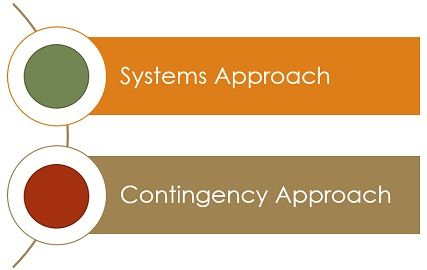 A number of approaches to management has been coined so far which seeks to describe the nature and content of the management with different assumptions and views. Of all the approaches developed systems approach has an upper hand over the other approaches, because of its closeness to reality. It suggests definite solutions to the problems.
A number of approaches to management has been coined so far which seeks to describe the nature and content of the management with different assumptions and views. Of all the approaches developed systems approach has an upper hand over the other approaches, because of its closeness to reality. It suggests definite solutions to the problems.
On the other hand, the contingency approach is an extended version of the systems approach. It relies on the assumption that there is no single way of management. So, basically the contingency approach says that the techniques of management have to be based on the circumstances. Therefore, it suggests probable and flexible solutions to the problem.
Now, we will discuss the differences between systems approach and contingency approach.
Content: Systems Approach Vs Contingency Approach
Comparison Chart
| Basis for Comparison | Systems Approach | Contingency Approach |
|---|---|---|
| Meaning | Systems approach studies the organization in its totality, as a system so that the resources of the firm can be organized to achieve the firm's objectives effectively. | Contingency Approach to management states that there is no single set of management principles which is ideal for all the organizations. |
| Organization | It considers all the organization as same. | It considers each organization as unique. |
| Contributors | Social Psychologists | Sociologists |
| Nature | Vague and unspecific. | Practical, specific and action-oriented. |
| Focuses on | Internal environment | External environment |
| Provides | A global theoretical model for understanding organizations. | Operational tools and techniques for assessing and solving problems. |
| Concerned with | Inter-dependencies and interactions among system and subsystem. | Situational variables |
Definition of Systems Approach
The systems approach perceives the organization as an interdependent, unified system made up of interconnected parts, i.e. it suggests the interrelationship among various activities. The approach tends to find out the kind of relationship existing among different components of the concern, which is regarded as a whole system.
The system refers to an established set of interlinked and interacting components, arranged in a specific sequence, to produce something of value. These components are nothing but subsystems, i.e. departments – production, marketing, purchase, human resource, research and development, finance, etc.
Characteristics of a System
- Parts are interdependent and interrelated. The whole system is divided into three parts – input, process and output
- The system is made up of a number of subsystems.
- Each system can be distinguished from the other in terms of their norms, roles, processes, structures, objectives, etc.
- System is open
- Systems influence and get influenced by other systems.
In a systems approach, the organization is viewed as a complex but unified whole, comprising of mutually interdependent and interreacting components, called a subsystem. The approach holds that manager of the organization needs to be precise when it comes to decision making and flow of information.
It focuses on the following aspects:
- Systems approach incorporates all the elements for the effective functioning of the organization.
- Goals can be achieved easily as it takes into account every aspect of the problem and maintains a cordial relationship between different elements so that they can work in tandem to accomplish the goals.
- It helps in acquiring and maintaining the factors of production for ensuring the smooth functioning of the enterprise.
- It assists in adapting to the internal needs and changes in the business environment so as to survive and grow.
Definition of Contingency Approach
Contingency Approach as the name suggests implies immediate contingent circumstances. A good organization adjust their planning, organizing, staffing, directing and controlling as per the situations. This means that all the organizations are different concerning nature, size, target audience, offerings, etc and so they face different situations and have to be managed differently. Here, situations are considered as contingent variables.
It is based on the idea that there is no universal solution to many problems, as organizations, people and circumstances do change over time. It is also called a situational approach. Hence, the approach is of the view that the organization acknowledges and responds to these situations as and when they arise.
It stresses on the fact that when a decision has to be made by the managers, they should consider all the factors of the existing situation and respond to those factors that are key to the current situation.
Features of Contingency Approach
- No action is universal which differs with the situation.
- The action of management is contingent and susceptible to external environment and subsystems
- Policies and practices of the management are subject to change according to the changes in the business environment.
- Human relations skills are essential for the managers to accommodate change as well as to stabilize it.
Assumptions of Contingency Approach
- No universal or one best way to manage the organization.
- Organizational design and its subsystems must ‘fit’ with the business environment in which the organization is operating.
- An effective organization not just have a perfect fit with the business environment but also between its subsystems.
- An organization’s needs are better fulfilled when the organization design is proper and the management style is appropriate, concerning the tasks carried out and the nature of the workforce.
Key Differences Between Systems Approach and Contingency Approach
The difference between the systems approach and contingency approach are discussed as under:
- A systems approach to management states that a company is an interconnected system, which is composed of various subsystems, which are nothing but business units/sections/departments. On the other hand, the contingency approach holds that management effectiveness is dependent upon the conditions.
- System’s approach considers all the organizations as same, as well as the background of the organization, is not taken into account. As against contingency approach considers each organization as unique and different, and background of the organization is taken into account.
- The systems approach is developed by social psychologists, whereas contingency approach is contributed by sociologists.
- When it comes to nature, the systems approach is vague and unspecific, while contingency approach is practical, specific and action-oriented.
- Systems approach focuses on the internal environment of the firm. In contrast, the contingency approach stresses on the external environment of the firm.
- The systems approach provides a global theoretical model for understanding organizations. Conversely, the contingency approach provides operational tools and techniques for assessing and solving problems.
- The systems approach is concerned with the interdependence and interplay among the system and its components. On the contrary, the contingency approach is related to the nature of interdependencies and the impact of the environment on the organizational design and managerial style.
Conclusion
To sum up the discussion, systems approach states the situation in which a certain kind of organization can operate effectively. On the other hand, the contingency approach is based on the premise that there is no one best organizational structure, instead, a suitable structure depends on the circumstances which the organization encounters.






Leave a Reply